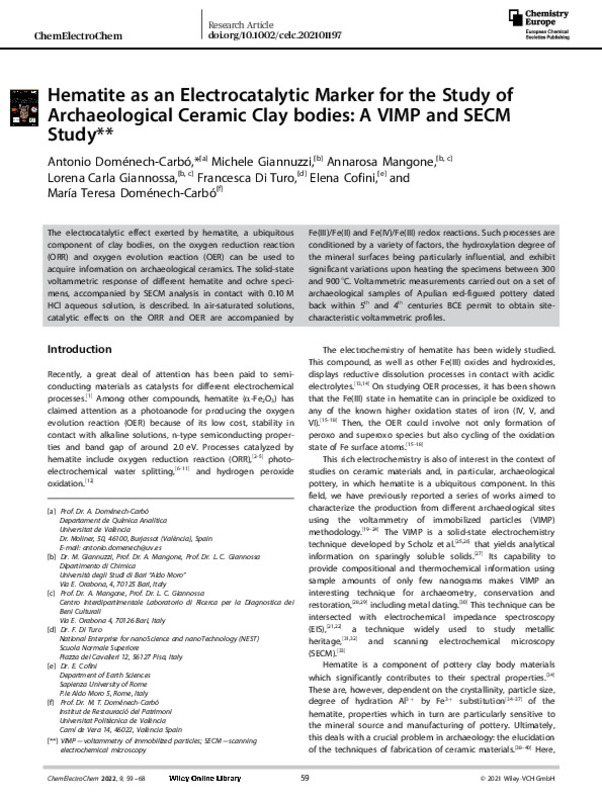JavaScript is disabled for your browser. Some features of this site may not work without it.
Buscar en RiuNet
Listar
Mi cuenta
Estadísticas
Ayuda RiuNet
Admin. UPV
Hematite as an Electrocatalytic Marker for the Study of Archaeological Ceramic Clay bodies: A VIMP and SECM Study**
Mostrar el registro sencillo del ítem
Ficheros en el ítem
| dc.contributor.author | Doménech-Carbó, Antonio
|
es_ES |
| dc.contributor.author | Giannuzzi, Michele
|
es_ES |
| dc.contributor.author | Mangone, Annarosa
|
es_ES |
| dc.contributor.author | Giannossa, Lorena Carla
|
es_ES |
| dc.contributor.author | Di Turo, Francesca
|
es_ES |
| dc.contributor.author | Cofini, Elena
|
es_ES |
| dc.contributor.author | Domenech Carbo, Mª Teresa
|
es_ES |
| dc.date.accessioned | 2022-10-06T18:05:55Z | |
| dc.date.available | 2022-10-06T18:05:55Z | |
| dc.date.issued | 2022-01-27 | es_ES |
| dc.identifier.uri | http://hdl.handle.net/10251/187202 | |
| dc.description.abstract | [EN] The electrocatalytic effect exerted by hematite, a ubiquitous component of clay bodies, on the oxygen reduction reaction (ORR) and oxygen evolution reaction (OER) can be used to acquire information on archaeological ceramics. The solid-state voltammetric response of different hematite and ochre specimens, accompanied by SECM analysis in contact with 0.10 M HCl aqueous solution, is described. In air-saturated solutions, catalytic effects on the ORR and OER are accompanied by Fe(III)/Fe(II) and Fe(IV)/Fe(III) redox reactions. Such processes are conditioned by a variety of factors, the hydroxylation degree of the mineral surfaces being particularly influential, and exhibit significant variations upon heating the specimens between 300 and 900 degrees C. Voltammetric measurements carried out on a set of archaeological samples of Apulian red-figured pottery dated back within 5(th) and 4(th) centuries BCE permit to obtain site-characteristic voltammetric profiles. | es_ES |
| dc.description.sponsorship | The work was carried out within the framework of project PID2020-113022GB-I00 which was financially support by Ministerio de Ciencia e Innovacion and Agencia Estatal de Investigacion (AEI) of the Spanish government. | es_ES |
| dc.language | Inglés | es_ES |
| dc.publisher | John Wiley & Sons | es_ES |
| dc.relation.ispartof | ChemElectroChem | es_ES |
| dc.rights | Reserva de todos los derechos | es_ES |
| dc.subject | Voltammetry | es_ES |
| dc.subject | Hematite | es_ES |
| dc.subject | Ceramic clays | es_ES |
| dc.subject | Oxygen reduction reaction | es_ES |
| dc.subject | Oxygen evolution reaction | es_ES |
| dc.subject.classification | PINTURA | es_ES |
| dc.title | Hematite as an Electrocatalytic Marker for the Study of Archaeological Ceramic Clay bodies: A VIMP and SECM Study** | es_ES |
| dc.type | Artículo | es_ES |
| dc.identifier.doi | 10.1002/celc.202101197 | es_ES |
| dc.relation.projectID | info:eu-repo/grantAgreement/AEI/Plan Estatal de Investigación Científica y Técnica y de Innovación 2017-2020/PID2020-113022GB-I00/ES/APLICACION DE TECNICAS AVANZADAS DE ELECTROQUIMICA DE ESTADO SOLIDO Y MICROSCOPIA EN EL ESTUDIO DE RESTOS ARQUEOLOGICOS DE NATURALEZA ORGANICA/ | es_ES |
| dc.rights.accessRights | Abierto | es_ES |
| dc.contributor.affiliation | Universitat Politècnica de València. Departamento de Conservación y Restauración de Bienes Culturales - Departament de Conservació i Restauració de Béns Culturals | es_ES |
| dc.description.bibliographicCitation | Doménech-Carbó, A.; Giannuzzi, M.; Mangone, A.; Giannossa, LC.; Di Turo, F.; Cofini, E.; Domenech Carbo, MT. (2022). Hematite as an Electrocatalytic Marker for the Study of Archaeological Ceramic Clay bodies: A VIMP and SECM Study**. ChemElectroChem. 9(2):59-68. https://doi.org/10.1002/celc.202101197 | es_ES |
| dc.description.accrualMethod | S | es_ES |
| dc.relation.publisherversion | https://doi.org/10.1002/celc.202101197 | es_ES |
| dc.description.upvformatpinicio | 59 | es_ES |
| dc.description.upvformatpfin | 68 | es_ES |
| dc.type.version | info:eu-repo/semantics/publishedVersion | es_ES |
| dc.description.volume | 9 | es_ES |
| dc.description.issue | 2 | es_ES |
| dc.identifier.eissn | 2196-0216 | es_ES |
| dc.relation.pasarela | S\456321 | es_ES |
| dc.contributor.funder | AGENCIA ESTATAL DE INVESTIGACION | es_ES |
| upv.costeAPC | 1089 | es_ES |








